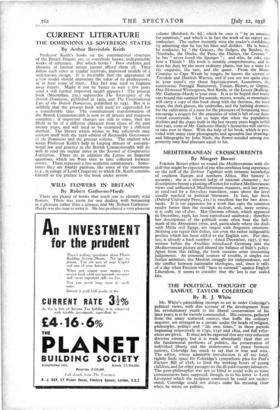There are plenty of books that teach one to identify
wild flowers. There was room for one dealing with botanising as a pleasure rather than a science, and Mr. Robert Gathorne- Hardy was the man to write it. He has produced a very pleasant
volume (Batsford, 8s. 6d.) which he says is " by an amateur for amateurs," and which is in fact the work of aziexpert and enthusiast.. The author instantly wins the reader's confidence by admitting that he has his likes and dislikes. He is bored, he confesseS, by " the Grasses, the Sedges, the Rushes, the Hemlocks, the Docks, the Peas, the Daisies, the Cresses " , he has " never loved the Spurges " ; and who, he asks, can love a Thistle ? His book is notably comprehensive, and he does his :duty by the more ordinary plants, but has a taste for the exquisite,. the rare, and the queer. From the Home Counties to Cape Wrath he ranges, he knows the secrets of Teesdale and Dawlish Warren, and if you are not quite clear in your mind's eye about Squinancywort, Lousewort, the carnivorous Portugal Butterwort, Tutsan, Bistort, or Orpine, One-Flowered Wintergreen, Red Rattle, or the Lesser Skullcap, Mr. Gathorne-Hardy is your man. It is to be hoped that many cars bound this summer for seaside, moors, woods, or mountains will carry a copy of this book along with the thermos, the road maps, the dark glasses, the umbrellas, and the bathing drawers, for the cultivation of a taste for the pleasures of botanising must encouragea respect Toi• the amenities of what is left of our dese- crated countryside. Let us hope that when the population declines and the slums built in the last twenty years begin to fall into ruin, some of Mr. Gathorne-Hardy's favourites will survive to take root in them. With the help of his book, which is pro- vided with many clear photographs and agreeable line drawings and lithographs by John Nash, the flower-minded among our pbsterity may find pleasure equal to his











































 Previous page
Previous page